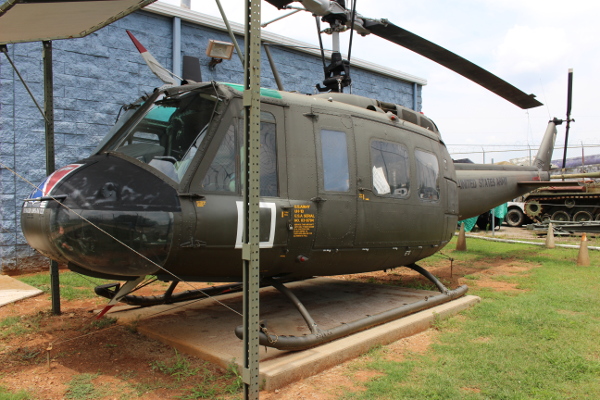Display Top (L to R)
CH 46 Boeing Sea Knight - USMC
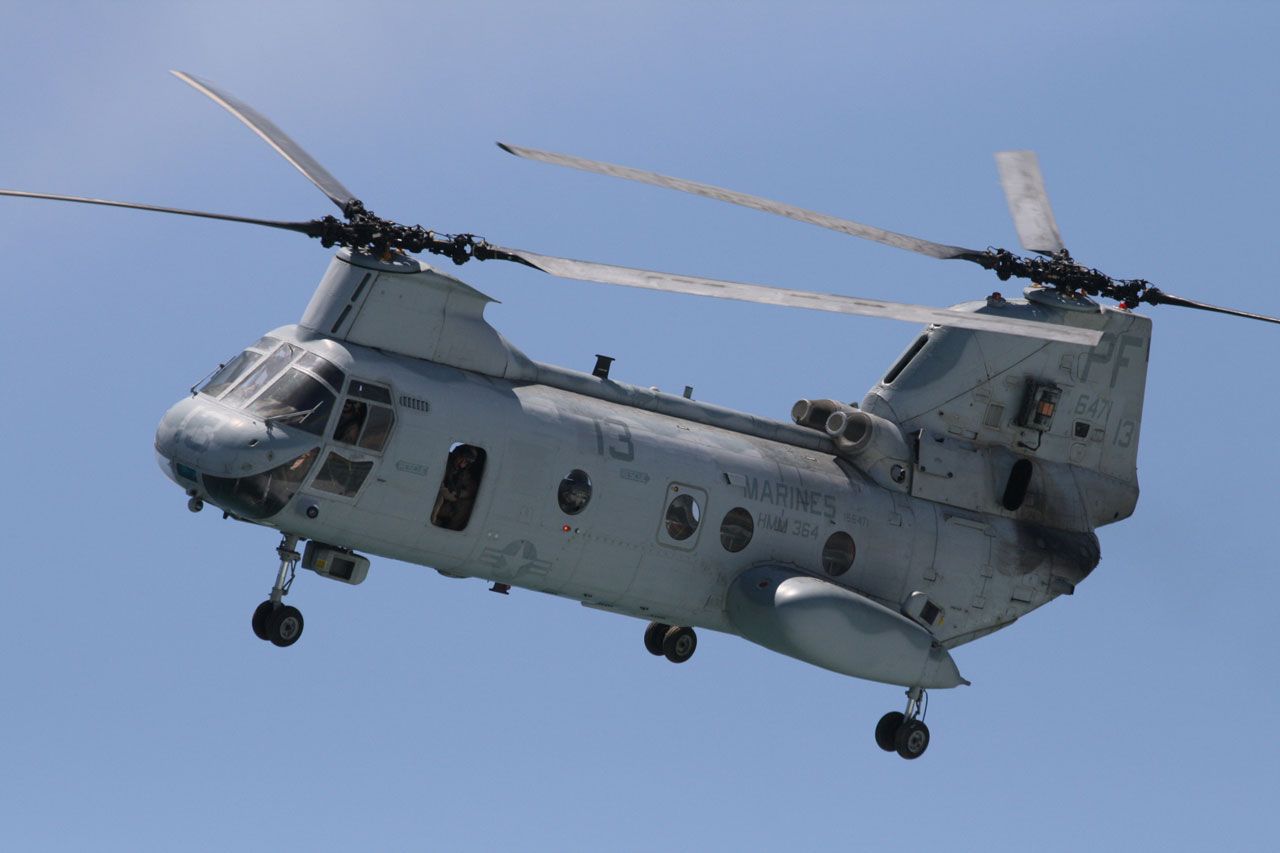
The Boeing CH-46 Sea Knight is a tandem rotor transport helicopter designed by Vertol and manufactured by Boeing. The Sea Knight was introduced in 1964 and was the successor to first generation rotor craft such as the H-21. The Sea Knight was operated by the USMC to provide all weather day or night transport of troops and equipment and to perform SAR Search and Rescue operations. The Sea Knight also served as medium lift utility helicopter for the US Navy. The Sea Knight is equipped with two counter rotating rotors which are powered by twin turbo shaft engines. The engines are coupled so that either can drive both rotors in case of a loss of power in one engine. Each rotor has three blades which are designed to fold for ease of transport. The CH-46 utilizes a fixed tricycle landing gear. The majority of the interior space is configured for use as cargo bay. The CH-46 is typically operated by a crew of three.
Mig 29 - Russia 
The Mig 29 is a twin engine jet fighter aircraft designed in the Soviet Union by the Mikoyan design bureau. It was developed in the 1970's as air-superiority fighter. The Mig 29 was developed to counter modern US aircraft such as the F16. Its primary purpose is to perform combat against enemy aircraft, but is is capable of serving in a variety of roles. The Russian Air Force is the largest operator of the Mig 29 but export versions have been delivered by over 30 countries around the world. The NATO designation for the Mig 29 is "Fulcrum". Principal characteristics of the aircraft are the mid mounted swept wings, swept tail planes and two vertical fins mounted on booms outboard of the engines. The Mig 29 has hydraulic controls but does not incorporate a fly-by-wire flight control system. It is very agile and has soft controls integrated to prevent the pilot from over stressing the aircraft. It is powered by two Klimov RD-33 turbofan engines. The Mig 29 has a range of over 900 miles without external fuel tanks. The cockpit is fitted with conventional instruments and a Head Up Display. Its high bubble canopy provides excellent visibility. The baseline MiG-29B has a Phazotron RLPK-29 radar fire control system which includes the N019 Sapfir 29 look-down/shoot-down coherent pulse-Doppler radar and the Ts100.02-02 digital computer. The N019 Radar designed was compromised by Adolf Tolkachev’s betrayal of the radar to the CIA, for which he was executed in 1986.
E-3 Boeing Sentry AWACS - USAF
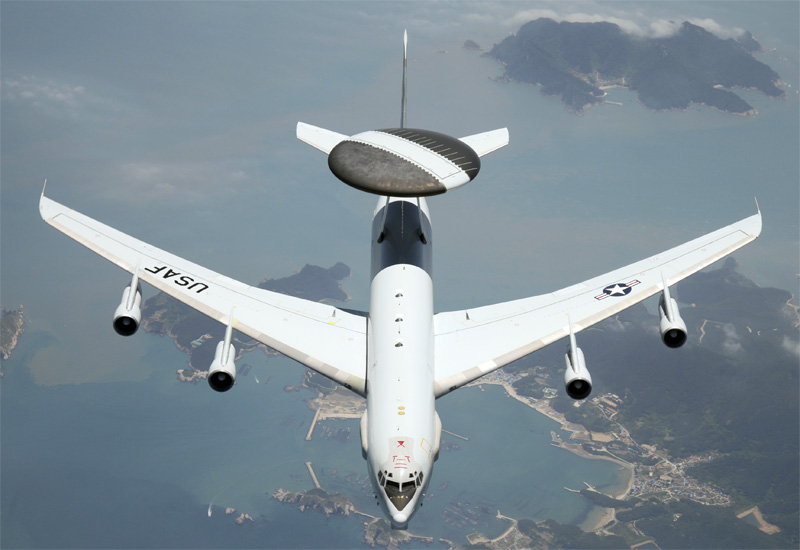
The Boeing E-3 Sentry is an airborne early warning and control aircraft developed by Boeing in 1972. Its design is based on the Boeing 707 Airliner. The E-3 is an AWACS aircraft designed to provide command,control, surveillance, and communications. The E-3 replaced the earlier EC-121 Warning Star surveillance aircraft. The most obvious visual characteristic of the aircraft is the rotating radar dome which is a component of the radar system that allows the aircraft to detect, identify and track airborne enemy forces. Surveillance information from the aircraft provides commanders of air operations the ability to maintain control of the battlefield from remote distances. The hydraulic controlled radar dome allows the AN/APY-2 passive radar to provide surveillance from the earth's surface up to the stratosphere over land or water. The E-3 is also equipped with navigation and communications systems and has 14 consoles to display surveillance, identification, weapons control, battle management, and communications data which can be forwarded in real time to command and control centers in rear areas and on ships. On board Generators provide 1 megawatt of electrical power required by the various electronic system on the aircraft. The radar, combined with a secondary surveillance radar and electronic support measures provides a look down capability, to detect, identify, and track low-flying aircraft, while eliminating ground clutter returns.
C-5 Lockheed Galaxy - USAF

The Lockheed C-5 Galaxy is a large transport aircraft. The aircraft is utilized by the USAF for intercontinental strategic airlift for personnel and equipment. The C-5 has been in service since its introduction in 1969. The newest version of the C-5 is expected to operate well into 2040. Since its introduction, the C-5 has served in every major military conflict including Afghanistan, Iraq, and Vietnam. The C-5 is a high wing configuration with a high T-tail vertical stabilizer. The aircraft is powered by 4 TF39 turbofan engines. The C-5 has twelve internal fuel tanks and is equipped for in-flight refueling. The interior is configured to accommodate 80 passengers. Cargo doors at the front and rear of the aircraft allow drive through loading and unloading of cargo. In 1974 a C-5 was used to conduct an air-launched ballistic missile test of a Minuteman ICBM over the Pacific Ocean. The aircraft is typically crewed by 7 personnel. It has a capacity of 280,000 pounds. Its top speed is 530 mph and its range is 5,500 miles.
Shelf 1 1/35 scale Left to right
F6F Grumman Hellcat - US Navy - World War II

The Grumman F6F Hellcat is an American made carrier based fighter aircraft and is the successor to the F4F Wildcat. The F6F was introduced in 1943 and became the dominant US Navy fighter during the later stages of the Pacific War. The F6F was powered by the Pratt & Whitney R2800 engine also used by the Corsair Vought and the Republic P-47 Thunderbolt. It quickly earned a reputation as an capable and reliable fighter aircraft and it tipped the balance of air superiority to the Allies. The F6F was designed to counter the Japanese Zero and was considered successful in doing so. The F6F was also designed for ease of manufacture, rugged reliability, excellent flight characteristics and a capacity to endure damage and continue flying. The fuselage was sloping in front which gave the pilot better visibility. By the time the last Hellcat was produced in 1945, over 12,000 had been produced. The Hellcat was credited with 5,223 enemy aircraft kills, more than any other Allied navy aircraft. The F6F was armed with six .50 caliber M2 machine guns, had fully retractable landing gear, an armored cockpit and a bomb load of 2,000 pounds. The F6F was later replaced by the F8F Bearcat.
P-40 Warhawk - Unite States Army Air Corts (USAAC) - World War II
The P-40 Curtiss Warhawk is an American made single seat, single engine fighter and ground attack aircraft. The P-40 was an improved re-design of the Curtiss P-36 Hawk. The Warhawk was used by most Allied nations during WWII. It was the third most produced fighter aircraft of WWII. Over 13,000 were produced. The Curtiss Warhawk first saw action in the China campaign in 1940. The P-40 played a significant role in North Africa, the Pacific and in China. The P-40 was originally designed to serve as a pursuit aircraft. It was very agile at low and medium altitudes, but had decreasing performance at high altitudes. The structural strength of the design of the P-40 allowed it to perform high speed turns and maneuvers. The design was very robust and allowed the aircraft to tolerate some damage and remain flying. The range of the P-40 was roughly similar to the Messerschmitt Bf 109. The P-40 gained it's fame as the aircraft used by the American Volunteer Group (The Flying Tigers) as pictured above.
P-39 Bell Airacobra -USAAC - World War II
The P-39 Airacobra was produced by Bell Aircraft for the US Army Air Forces. The P-39 is a low-wing single engine fighter. An interesting feature of the aircraft is its mid-fuselage Allison V-1710 liquid cooled V12 engine which drove the propeller using a 10 ft long shaft which ran underneath the cockpit. The P-39 was designed to serve as a platform for the 37mm T-9 cannon and the entire structure was made to support this purpose. The pilots seat was located above the drive shaft for the propeller so the pilot was positioned higher that other similar aircraft and as a result, had a better view. The P-39 D model was armed with two .50 caliber and four .30 caliber machine guns. The heavy weight of the aircraft and the limited performance rendered the P-39 inferior to European aircraft of the period.
P-43 Republic Aviation. Lancer - USAAC - World War II

The P-43 Lancer was a low-wing monoplane fighter aircraft built by Republic Aviation. It was introduced in 1941. The P-43 had excellent high altitude performance, as demonstrated by photographs taken of Mt Everest taken from above by pilot Robert Lee Scott junior. They also were known for excellent long range capability and was fast and well armed. They were known to have vulnerable fuel tanks that were not self sealing and they were not armored. The P-43 was retired from service in 1942. P43 aircraft were delivered to China via the Lend Lease Program. A total of 270 were produced. Its maximum speed was 356 mph, its range 650 miles and top ceiling 35,000 ft.
P-36 Curtis Hawk - USAAC - World War II

The P-36 Hawk is an early American designed fighter aircraft made by Curtiss-Wright. The P-36 was based on a new design concept and made extensive use of metal structure and was powered by a powerful radial engine. The P-36 had a top speed of about 280 mph and was armed with a .30 and .50 caliber machine guns mounted in the cowling which fired through the propeller arc. The P-36 lacked armor and self sealing gas tanks. The P-36 had landing gear that rotated 90 degrees as they retracted into the wheel wells which was a feature patented by Boeing. The P-36 had a high power-to-weight ratio and low wing loading which yielded very favorable flight capability. The P-36 Hawk saw little use with the US Army Air Force, but was heavily used by other nations including France, China and the UK.
2nd Shelf (L to R)
F4 B McDonnell Douglas (Phantom II) - US Navy - Vietnam War

US Marines twin-engine, long-range supersonic jet fighter-bomber
The F4 Phantom is a tandem, two seat, twin engine interceptor/fighter-bomber developed for the US Navy by McDonnell Aircraft. The F4 was introduced for use by the US Navy in 1961 and was soon adopted by the USMC and the US Air Force. The aircraft was produced from 1958 through 1981. Over 5,000 were produced making it the most proliferous American supersonic aircraft in history. The F4 is a large aircraft and can carry over 18,000 pounds of bombs. It served as the principal air superiority fighter for the U.S. Air Force, Navy, and Marine Corps during the Vietnam War. It was eventually replaced by the more modern F-14, 15 and F-16, but remained in service until 1996. The F4 saw extensive use in the Arab-Israeli conflicts and has been in service with many other nations around the world. The F4B is an all-weather carrier-based fighter and ground attack aircraft variant used by the US Navy and USMC.
F-86 North American (Sabre) USAF - Korean War

The F-86 Saber is a Supersonic jet fighter aircraft produced by North American Aviation. It was introduced in 1949 and was the first American swept wing fighter. The F-86 is considered to be one of the best fighter aircraft of the Korean War era. It is the most produced American jet fighter with a total of 9.860 produced. The F-86 is the first American aircraft design heavily influenced by German aerodynamic flight research data seized after the end of WWII. The F-86 was designed to serve as fighter-bomber and fighter-interceptor. The fighter-bomber variant of the F-86 could carry up to 2,000 pounds of bombs.
F-8 Vought (Crusader) US Navy - Vietnam War
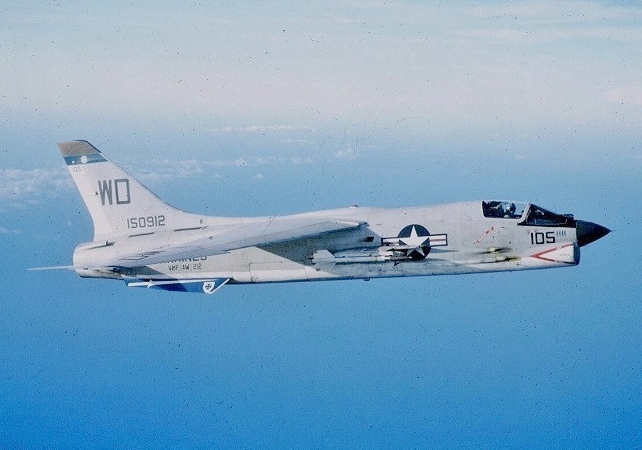
US Navy carrier-based jet fighter and fighter-bomber
The F-8 Vought was a single engine supersonic carrier based air superiority aircraft first introduced in 1957. The Crusader was the last American made fighter aircraft primarily armed with guns instead of missiles although it was armed with both. In Vietnam, the Crusader earned a reputation for achieving the highest kill ratio of any fighter aircraft 19:3. The Crusader was the first USAF fighter to engage in aerial combat with enemy aircraft from the Vietnam Peoples Air Force. A version of the Crusader, the RF8A was modified to perform reconnaissance missions. These were used to fly very low level reconnaissance mission over Cuba and obtained evidence of the installation of Soviet MRBMs
A-4 Douglas (Skyhawk) US Navy - Vietnam War
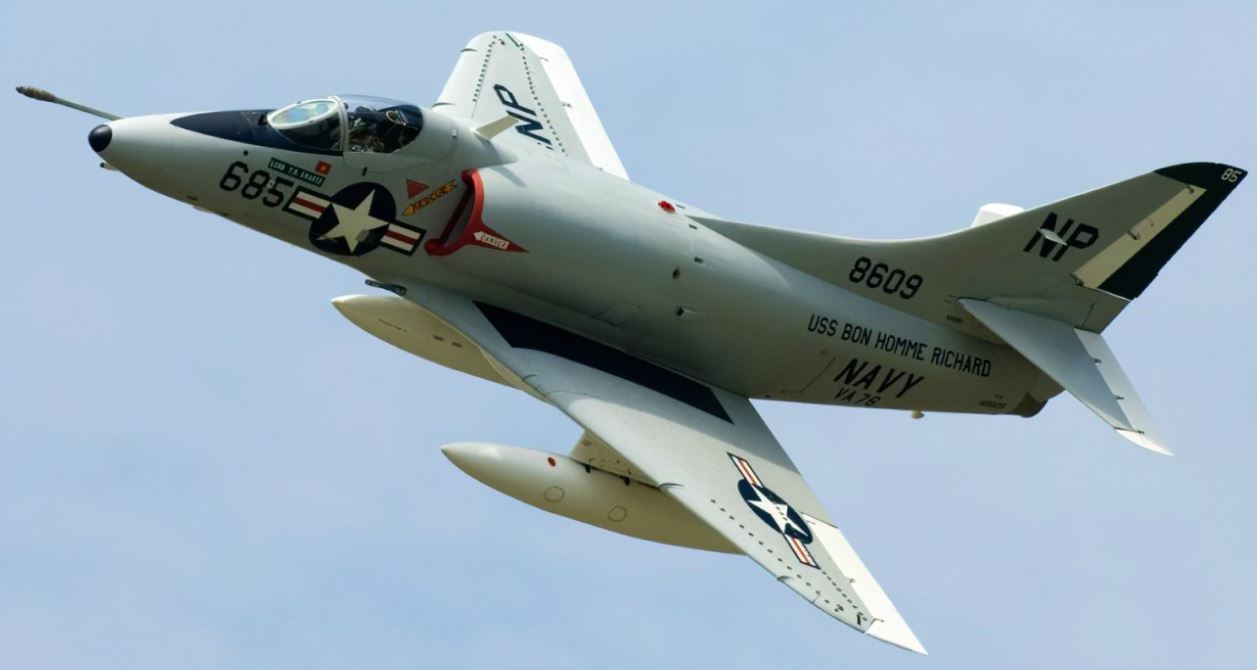
US Navy Single-seat supersonic fighter aircraft
The A4 Douglass Skyhawk is a single seat single engine light attack aircraft. It was developed for use by the US Navy and USAF and introduced in 1956. The aircraft employs a short span low-mounted delta wing configuration which was compact enough to allow efficient storage on carriers. They were relatively inexpensive to manufacture and very fast and maneuverable. The aircraft was armed with two 20mm cannons and had hard points for carrying a large variety of bombs, missiles, and rockets. The A4 was one of the first aircraft to perform "buddy-to-buddy" in flight refueling. Skyhawks were the U.S. Navy's primary light attack aircraft used over North Vietnam during the early years of the Vietnam War and a Marine Skyhawk is believed to have dropped the last American bombs on the country. The Skyhawk was the first U.S. warplane to be offered to the Israeli Air Force. Deliveries began after the Six-Day War, and A-4s formed the backbone of the IAF's ground-attack force. Almost 3,000 were produced.
F-16 General Dynamics (Fighting Falcon) USAF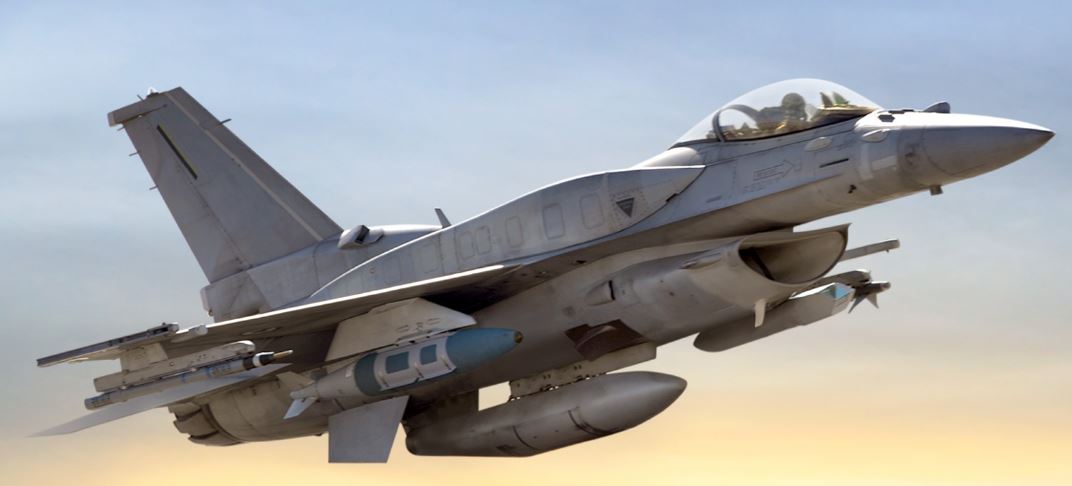
The F-16 is a multi-role fighter aircraft developed by General Dynamics for the USAF. It was first introduced into service in 1978 as air superiority fighter. It is the worlds most numerous fixed wing military aircraft with 4,600 produced. The F-16 was designed to fulfill a NATO requirement to replace the F104G and a USAF requirement to replace the F105 and F4 Phantom jet aircraft. The design was chosen from a competition including the French Mirage F1M-53, the Anglo-French SEPECAT Jaguar, the Northrop P-530 Cobra, and the Saab 37E Eurofighter. The F-16 is small and lightweight but has sophisticated avionics including a Head Up Display and Westinghouse AN/APG-66 Fire Control Radar and employs advanced aerodynamic engineering. Its design is optimized for high agility combat. The F-16 is the first the first jet aircraft to maneuver at 9Gs and has a maximum speed of over Mach 2. Its frame-less bubble canopy window offers excellent visibility. It is armed with a 20 mm M61 Vulcan cannon and can carry a variety of munitions on external mounts. The F-16 is designed to be inexpensive and simple to maintain. The F-16 uses a cropped delta-wing configuration, an underslung air intake and tricycle landing gear. The F-16 is the first jet aircraft to be designed to be slightly aerodynamically unstable in order to obtain maximum maneuverability and employs a fly-by-wire flight control system which the pilot is completely dependent upon to fly the aircraft. The F-16 has been heavily employed by the USAF in Operation Desert Storm and during the War in Afghanistan, by the Pakistan Air Force against the Indian Air Force, by Turkey, in its action against Kurdish fighters, and the Israeli Air Force, which used F-16s in its strike against nuclear facilities in Baghdad developed by Saddam Hussein. The F-16 is still in active service after 46 years.
U-6 De Havilland (Beaver)
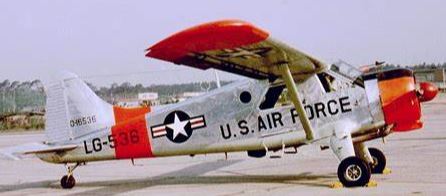
US Army utility transport and liaison airplane
The De Havilland DHC-2 Beaver is a single engine prop-driven STOL short takeoff and landing aircraft developed by De Havilland of Canada. The aircraft was primarily developed for a variety of civilian aviation duties. The DHC-2 was first introduced in 1948. The aircraft was designed to be fitted with wheels, skis or floats and intended to operate in rugged and remote areas of the world. The STOL capability of the aircraft allowed it to operate in locations with very limited access. The DHC-2 can operate in all seasons and in a variety of weather conditions. The DHC-2 is powered by a 450 hp Pratt and Whitney radial engine. The aircraft can be configured for carrying cargo or passengers. The DHC-2 was employed by the US Army and hundreds are still in service today.
Royal Navy Sea Harrier
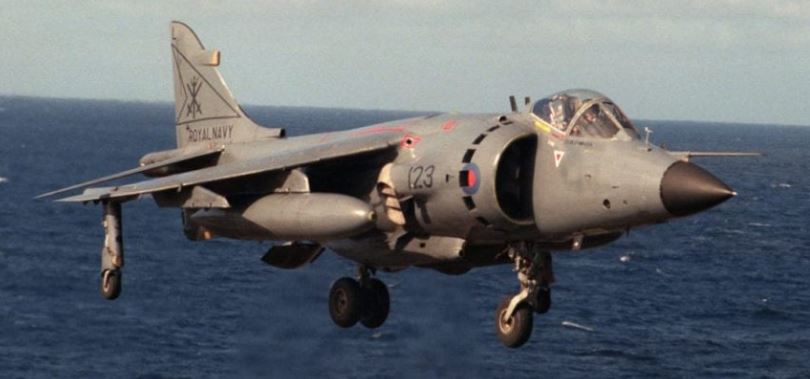
British carrier-capable attack aircraft
The Sea Harrier is a jet fighter aircraft built by British Aerospace. It is a STOL Short Takeoff /Vertical Takeoff/Vertical landing jet fighter, reconnaissance, and attack aircraft. It is a member of the Harrier Jump Jet family of aircraft. The Sea Harrier was introduced into service in 1980. The Sea Harrier is a subsonic interceptor designed to operate on carriers and intended to provide fleet security. The Sea harrier is powered by a single Rolls Royce turbo fan engine with vectorable nozzles. It is equipped with a raised bubble canopy for enhanced visibility for the pilot and has corrosion resistant alloys and coatings to protect against the marine environment. The Sea harrier is equipped with the Blue Vixen radar system which is considered one of the most advanced pulse doppler radar systems in existence. Sea Harriers saw action in the Falklands War where they served primarily in the air defense and ground attack role. The Sea Harriers demonstrated greater maneuverability than the opposing aircraft operated by the Argentinians. The Sea Harrier was retired from service by the Royal Navy in 2006. A total of 98 were built.
F-5 Northrop (Tiger) Fighter

Single-seat twin-engine supersonic fighter aircraft
The Northtrop F-5 is a supersonic light fighter aircraft developed and produced by Northrop Corporation. It was introduced in 1962 and intended to counter enemy aircraft such as the Mig 21. The F-5 was designed as a smaller and lighter aircraft (as compared with the F-4 Phantom) with lower costs for procurement and operation. The aircraft was designed for capability as day air-superiority and ground attack missions. The aircraft was used extensively in the Vietnam War flying over 2,600 sorties. from the 3rd Tactical Fighter Wing at Bien Hoa over South Vietnam and from Da Nang Air Base where operations were flown over Laos. Its performance in the ground attack role was deemed was deemed very successful. Production of the F-5 was discontinued in 1987, but the aircraft remains in service as a trainer. Export versions have been purchased by many countries over the world. Its maximum speed is 1082 mph. Its range is 550 miles and service ceiling is 51,000 ft. It is armed with two .20 mm M39A2 Revolver cannons and 7 hardpoints for carrying a variety of rockets, missiles, and bombs.
Wyvern Westland Aircraft - 1950s
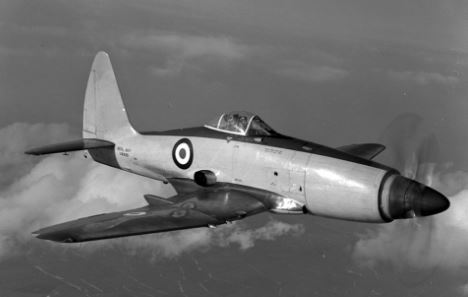
British single-seat carrier-based multi-role strike aircraft British,
The Westland Wyvern was a British multirole strike aircraft designed for carrier based operation introduced into service in 1953. The design is unusual in that the engine is mounted behind the pilot and connected to the props via a shaft that ran under the cockpit. This allowed the cockpit to be mounted higher which resulted in more optimal visibility for pilots. The aircraft is a low-wing configuration with a tail-wheel undercarriage and uses contra-rotating props. 127 of these aircraft were built. The primary user was the British Royal Navy.
3rd Shelf (L to R)
Ka-27 (NATO name 'Helix' Kamov) Helicopter - Russia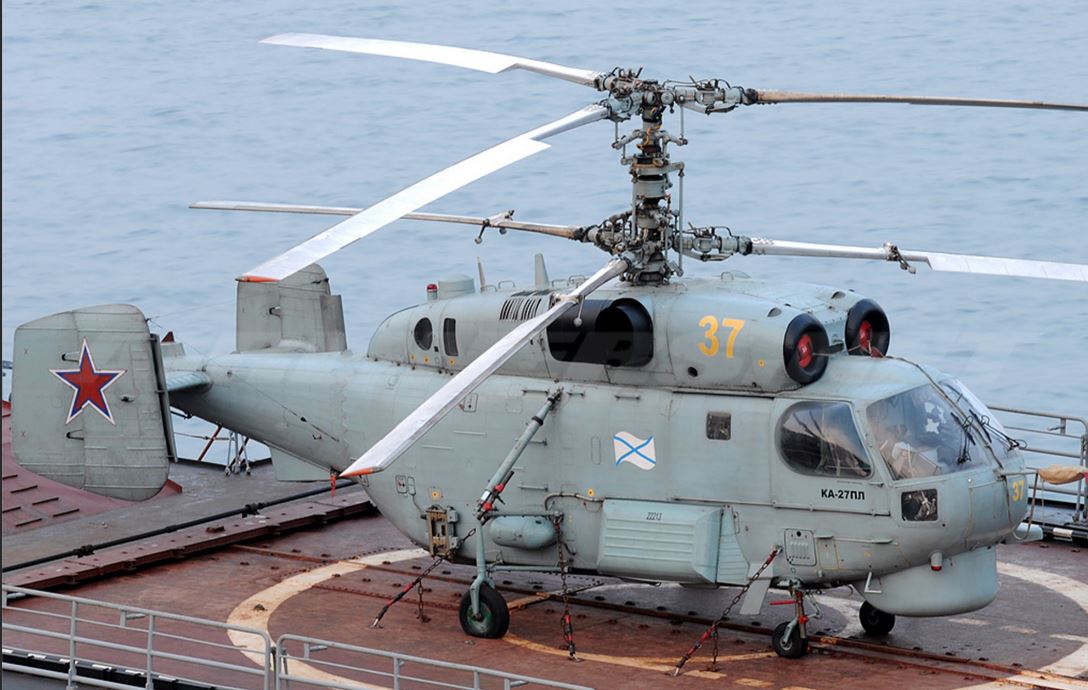
The Ka27 "Helix" helicopter is a military helicopter developed for the Soviet Navy. The Helix was developed primarily for anti-submarine warfare. It was first introduced in 1982 and remains in service. The Helix uses coaxial rotors and does not require a tail rotor. Although developed for military use, the Helix is also used non-military civilian service. The design with no tail rotor allows the helicopter to maneuver near obstacles and has exceptional accuracy when hovering. A variant called the Ka 32 is commonly used for construction of towers for overhead transmission lines. The Helix can carry a single torpedo, and is typically armed with a 7.62 machine gun with 1800 rounds, a 30 mm cannon with 250 rounds, and has external hardpoints for bombs, rockets and gun pods.
UH-1 Bell (Huey) Helicopter US Army
USA utility military helicopter powered by a single turboshaft engine
This helicopter (63-3794) was flown by Warrant Officer Robert Mason, (author of “Chickenhawk”), and has been restored bearing the markings of the helicopter at that time and is on display at the US Veteran's Memorial Museum.
UH-1 Iroquois, commonly known as the “Huey”, is a multipurpose military helicopter and is famous for its use in the Vietnam War. Development from the Bell Model 204, with initial designation of HU-1 (helicopter-utility), led to its nickname. It was first used by the military in 1959 and went into tri-service production in 1952 as the UH-1. The last ever produced was in 1986. More than 10,000 were made, of which the majority (apx. 7,000) were used in Vietnam.
AH-1 Bell (Cobra Helicopter US Army
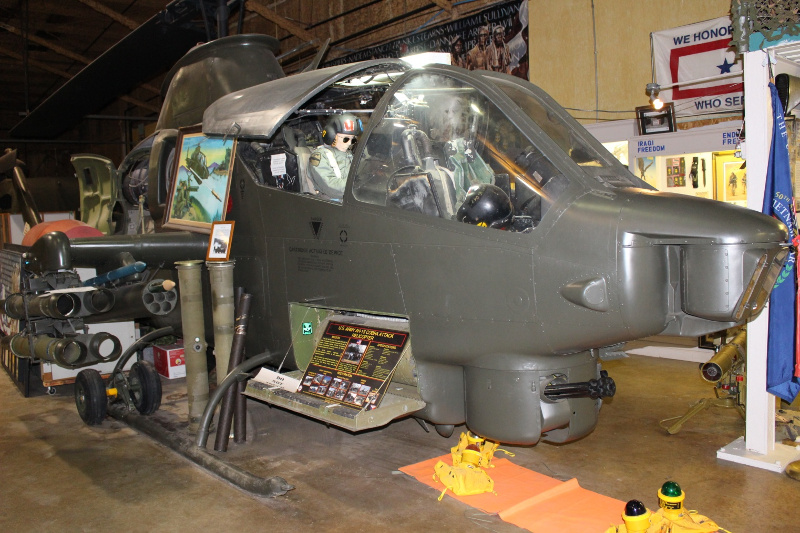
USA single engine attack helicopter
The Bell Ah-1S Cobra was used primarily for close air support of ground troops and also as an attack helicopter against armored formations. Highly maneuverable, heavily armed, the Cobra was well designed for its mission.
The AH-1S program upgrades all AH-1G, AH-1Q, AH-1R Cobras to the advanced modernized version.
The Cobra fleet was retired from the U.S. Army in 2001, but many different variants continue to serve with the U.S. Marine Corps and allied nations worldwide. A retired Cobra helicopter is on display at the US Veteran's Memorial Museum.
T62 Main battle Tank - Soviet
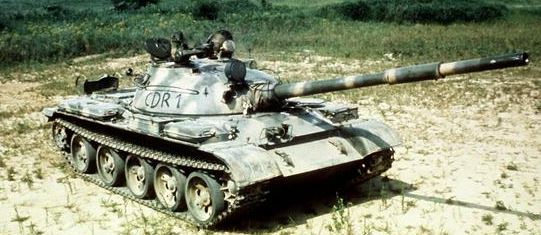
The T62 Main Battle Tank was first introduced in 1961. It is an evolution of the earlier T55 Main battle Tank. A typical noteworthy characteristic of the T62 is the very low profile and distinctive turret shape. The T-62 retains many of the features implemented on the T-55 with the exception of new mounting structure and turret required for the larger gun which was needed to cope with advances in enemy armor. It is noteworthy that the T-62 was the first Main battle Tank equipped with a smooth bore main gun. This new un-rifled gun was less accurate but had a higher velocity and much greater range than the main gun of the T-55. The 115 mm gun of the T62 had a higher muzzle velocity than the 90 mm and 105 mm guns used on modern western tanks. In addition to the 115 mm main gun, the tank is armed with a coaxial 7.62 mm machine gun, and a 12.7 mm DShK machine gun mounted next to the loaders hatch. The tank can store 40 rounds for the main gun and 2500 rounds for the coaxial gun. The main gun could fire BM-3 APFSDS-T, BK-4, BK-4M HEAT and OF-18 Frag-HE rounds and was capable of firing the first APFSDS kinetic ammunition. The T-62 uses torsion bar suspension and has five pairs of rubber tired road wheels. The tank is powered by a 12 cylinder engine producing 580 HP. The T-62 has the ability to generate a smoke screen by injecting diesel fuel into the exhaust system and can eject spent casings from the main gun through a port in the turret. The T-62 shares the same cramped conditions in the turret and poor ergonomics limited gun depression range as the T-55. The T-62 was twice as expensive to produce as the T-55. The T-62 is still currently in service. Over 22,700 have been built.
T72, main battle tank 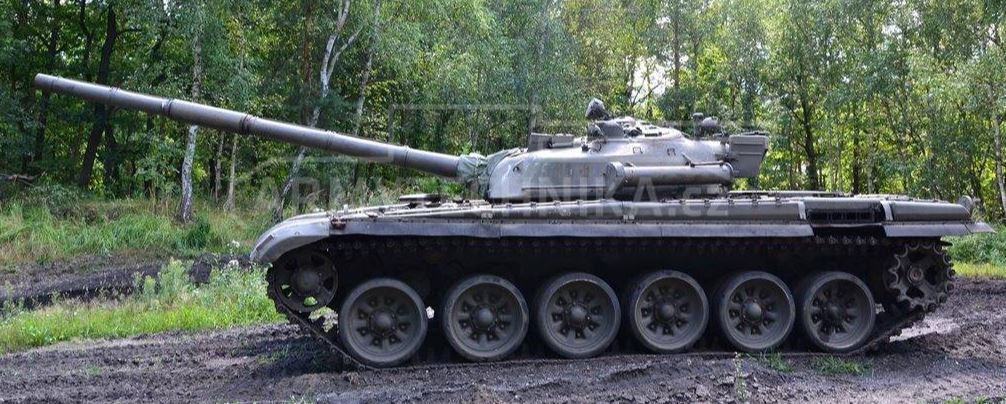
Soviet main battle tank with a 125 mm Gun
The T-72 is a main battle tank produced by the Soviet Union first introduced into service in 1970. The T-72 was developed from the earlier T-64 model. It is considered a 2nd generation main battle tank. The T-72 was the most common tank used by Warsaw Pact nations and has been widely exported to many nations around the world. Various versions have been in production for decades and many nations have produced special variants of the design. Original versions of the T-72 had homogeneous steel armor, but more modern versions are made with composite armor and fitted with reactive armor plates. The T-72 is very lightweight and compact, has NBC protection, and is designed to ford rivers up to 15 ft deep. The T-72 is armed with a 125 mm gun capable of firing ATGMs, HEAT and APFSDS ammunition. The T-72 is also equipped with an autoloader system for loading the main gun which eliminates one crewman. The T-72 has seen extensive service with over 40 countries around the world and has performed well against M60 Patton tanks and British Chieftain tanks. The T-72 is currently one of the primary tanks employed by the Armed Forces of Ukraine and the Russian Federation in the Ukraine War.
Leopard Tank (or Leopard 1) Porsche Germany

Germany main battle tank with a 120 mm Gun
The Leopard 1 is a main battle tank designed and built by Porsche in West Germany in 1965. Its design was optimized for excellent cross-country mobility and firepower. Upon its introduction, the leopard 1 was adopted by many nations around the world. The leopard was developed to replace the American M47 and M48 main battle tanks. The leopard 1 is armed with a 105 mm Royal Ordinance L7A3 rifled gun, 2 7.62 mm machineguns, and powered by a 10 cylinder multi-fuel engine producing 819 HP. The leopard in crewed by four persons and weighs almost 42 tons. Its maximum speed in 65 km.
4th Shelf (L to R)
M3 GM (Stuart) Light Tank - US Army -- World War II
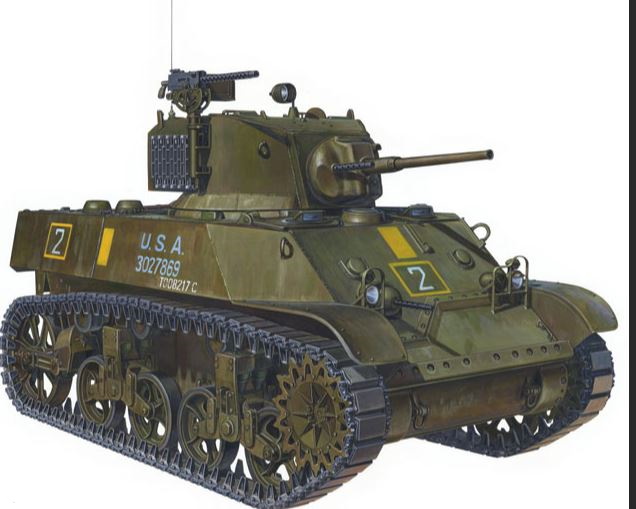
USA light tank 37 mm Gun
The M3 Stuart was an American made light tank produced during World War II. It was named after American Civil War general J.E.B. Stuart. The Stuart was first used in combat in the North Africa Campaign. They were also used against the Japanese in the Philippines were they proved effective in jungle warfare. The Stuart was produced between 1941 and 1944. The Stuart was armed with a 37 mm main gun and 5 .30-06 Browning M1919A4 machine guns. The Stuart was powered by air-cooled radial aircraft engines. The radial engine was placed at the rear of the vehicle, the transmission was in the front, and the two were connected by a drive shaft that ran through the middle of the fighting compartment. The M3 was roughly comparable to the Axis tanks such as the Panzer III, but inferior training resulted in generally poor performance on the battlefield. The Stuart was known to have some drawbacks such as the two man turret crew, and limited range of 75 miles. The Stuart was faster than the British counterpart, the Crusader. The Soviet Union also employed the Stuart through the Lend-Lease program. A total of over 22,000 Stuart tanks were built. A retired Stuart Tank is on display at the US Veteran's Museum.
British/US Lee/Grant Tank

British Grant Tank (left) shown with British American Tank (right).
The M3 Lee Tank was a medium tank used by the US Army during World War II. There were two models including the "Grant" with a British patterned turret, and the "Lee" with an American designed turret. The M3 was first introduced in 1941. The design was a compromise intended to quickly fill an urgent need for tanks at the beginning of the war. It was armed with a powerful sponson mounted 75 mm gun which prevented the tank from firing from hull down positions. The vehicle was made with a riveted design and had poor cross country performance. The vehicle also had a very high profile making it an easy target for enemy gunners. The Grant Lee was quickly replaced by the M4 Sherman. Over 6,000 were built. Production ended in 1942.
M3A1E1 Command Car -US Army - World War II
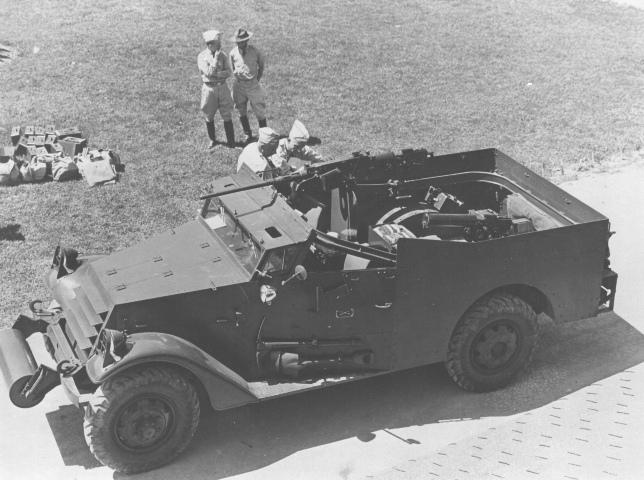
The M3A1E1 was an American produced open topped, four wheel drive armored car. The vehicle was designed for reconnaissance and was crewed by a driver and a commander. It could carry six passengers. The M3A1 was powered by a 6 cylinder gasoline engine and had a top speed of 50 mph and a range of 250 miles. The front bumper is fitted with an unditching roller. The M3A1E1 was armed with a .50 caliber M2 Browning machine gun. The E1 version of the M3A1 was equipped with a diesel engine which increased the fuel economy and range of the vehicle. A retired M3A1E1 is on display at the US Veteran's Museum.
M3A1 Half track -US Army - World War II

The M3A1 was an American produced armored personnel carrier used during World War II and the Cold War. The M3A1 was a successful design and was produced in large numbers. The chassis was widely adaptable and many variants were produced for different roles. The M3A1 was issued to armored infantry regiments. The M3A1 could carry twelve passengers. Infantry rifles were carried in brackets mounted behind the seats with ammunition and rations carried underneath. The vehicles were also fitted with brackets on the outside for carrying landmines. Early versions of the M3A1 were equipped with pintle mounted .50 caliber M2 Browning machine guns. Later versions were equipped with with a raised armored pulpit mount over the front passenger seat. The vehicle body was fully armored with an armored shutter for the vehicle radiator and adjustable bulletproof panels for the driver and passenger windows. A retired M3A1 APC is on display at the US Veteran's Museum.
M8 Ford Motor Company Light Armored Car -US Army - World War II
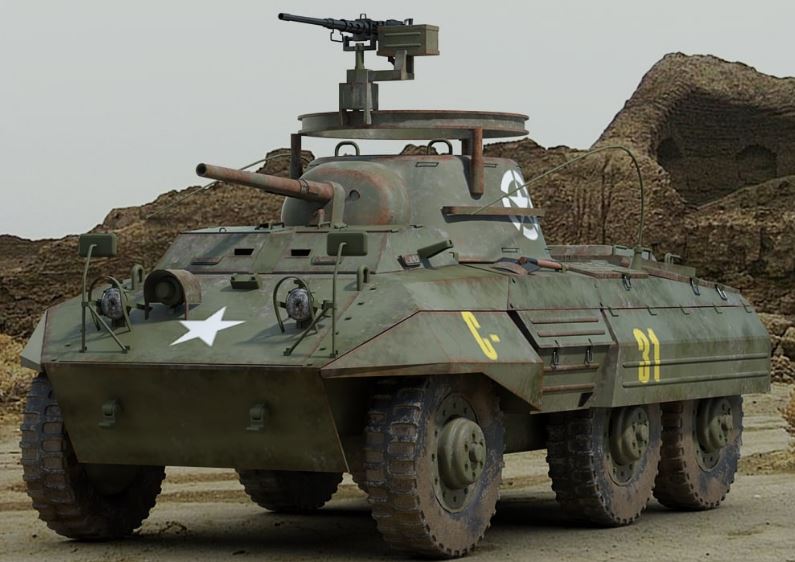
The M8 Armored Car is a 6x6 armored car produced by Ford Motor Company first introduced into service in 1943. The M8 was known for its on-road mobility and excellent speed. The M8 was initially designed under the concept of gun motor carriage. The .37 mm main gun proved to be ineffective against tanks and the vehicle was relegated to a reconnaissance role which required speed and agility. The M8 was equipped with long range radio sets to provide communications to exercise command and relay information from the battlefield. The M8 had an on-road range of 200-400 miles and a top speed of 55 mph. The M8 was only lightly armored with protection against small arms fire and was vulnerable to damage inflicted by mines. Despite its six wheel drive, it had poor mobility in off road conditions because of its limited turning radius and open differentials. The use of wheels instead of tracks also resulted in a higher ground pressure which yielded poor performance on soft surfaces. The M8 was operated by a crew of 4 and carried 80 rounds for the main gun. The M8 was powered by a 320 cubic inch engine which was relatively quiet and made the vehicle somewhat difficult to detect. A retired M8 Greyhound is on display at the US Veteran's Museum.
M20 armored command car -US Army - World War II
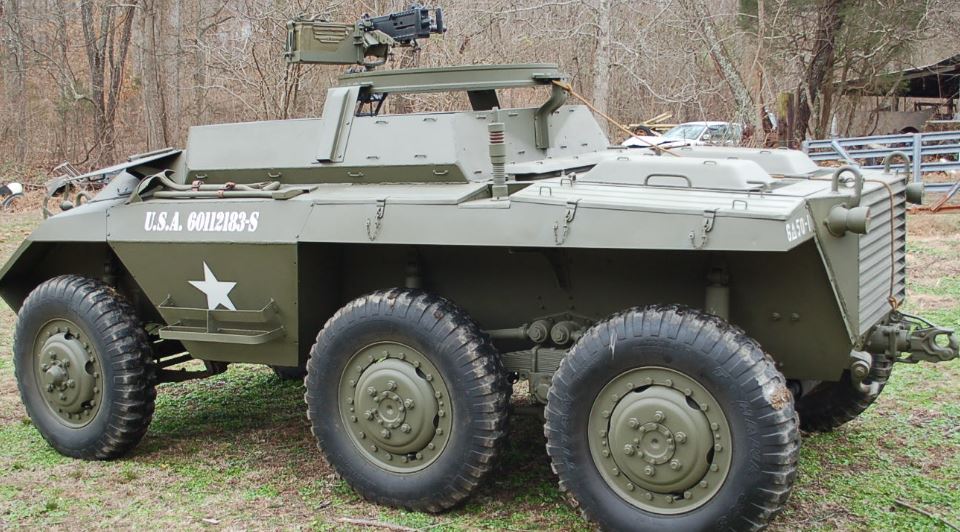
USA command, carrier/ammunition/cargo car
The M20 is a derivative of the M8 Greyhound with the omission of a turret which made this variant more suitable for reconnaissance and personnel transport. The vehicle was equipped with a single .50 caliber M2 Browning machine gun for defense against low flying aircraft, light armored vehicles and infantry. The vehicle was highly favored by advancing American and British armored columns for its high speed and on-road mobility. The M20 was lightly armored and had a large turning radius which limited its off-road mobility. However its wheeled configuration made it more reliable than tracked vehicles. The M20 was introduced into service during World War II but saw extensive post war service all over the world. The M20 had a top speed of 55 mph and a range of 350 miles.
M8 GM (Stuart) Howitzer Motor Carriage --US Army - World War II
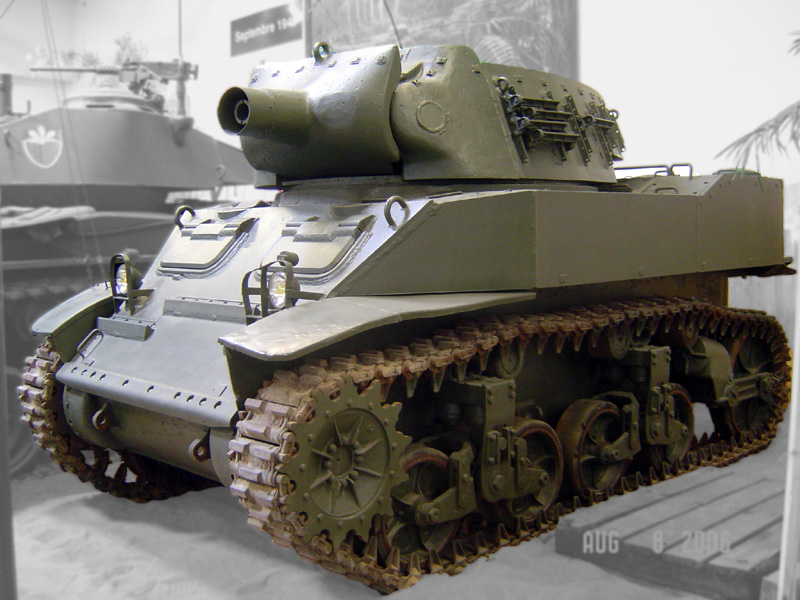
USA Howitzer Motor Carriage 75 mm Howitzer
The M8 Howitzer Motor Carriage was a self propelled howitzer designed to utilize the M5 Stuart tank chassis. The M8 was designed by the US Army Ordnance Department and built by the Cadillac Division of General Motors. The M8 was introduce in 1942 and in service from 1942 through the 1960s. The 75 mm Howitzer Motor Carriage M8 was assigned to the Assault Gun Troops of Cavalry Reconnaissance Squadrons in order to give them close support against enemy fortified positions. The high elevation +40/-20 degrees of the howitzer was useful for hitting enemies emplaced on the sides of hills. The M8 had an open top turret, was equipped with a 75 mm M3 howitzer and carried 46 rounds of ammunition. It was crewed by four personnel. It was phased out of service and replaced by the more heavily armored M4A3.
M4 Sherman 75 mm gun
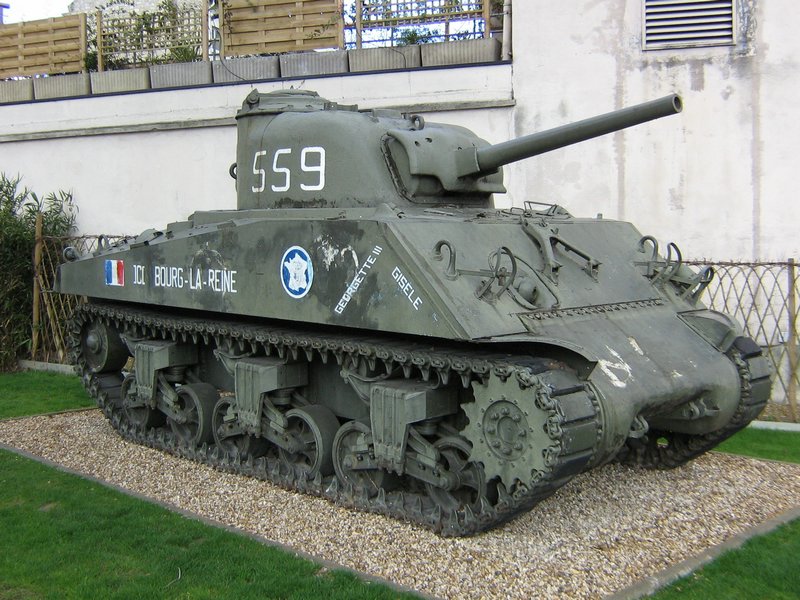
The M4 Sherman was an American produced medium tank employed by the US and its allies during World War II. Its design was optimized for ease of manufacturing which made it economical to produce and large numbers of these tanks were built. The M4 Sherman was introduced in 1942. During its service life almost 50,000 were made. The design of the Sherman was an evolution of the earlier M3 Lee/Grant medium tank with its sponson mounted main gun. The M4 has a fully traversable turret, a vertical volutte spring suspension, rubber bushed tracks, and a rear mounted gasoline fueled radial engine. The early versions were armed with a 75 mm main gun. Several variants were produced including the flamethrower "Zippo" tank, and British mine flail tank. The chassis was also the basis for several special purpose vehicles including recovery vehicles, self propelled artillery, and tank destroyers.
Willys Jeep

The Willys Jeep, formally known as the U.S. Army Truck is a light off-road military utility vehicle. The Willys was the primary light wheeled utility vehicle for the US and its allies during World War II. The Willys was a very successful vehicle and was built in large numbers to a standardized design. It was also the worlds first mass produced light four wheel drive car. During World War II large numbers were provided to US allies including the former Soviet Union. The Willys Jeep has a reputation for reliability and ruggedness and was designated an "International Historic Mechanical Engineering Landmark" by the American Society of Mechanical Engineers. The Willys was later succeeded by the M151 Jeep. The Willys was first introduced in 1941 and produced between 1941 and 1945. During its production over 600,000 were made. It weighs just over 2,400 pounds. A fully restored Willys Jeep is on display at the US Veteran's Museum.
M4A1, Sherman - World War II 
USA Medium Tank, 76 mm gun
The M4 Sherman Tank was the most widely used medium tank during WWII for US and Allied forces. Unlike more sophisticated designs of the time, the Sherman was very reliable and simple to manufacture. This resulted in one of its primary advantages which were the large numbers available. It was named for for the American Civil War general William Tecumseh Sherman. The M4 was an evolution of the earlier M3 tank. The M4 was the most produced tank in American history. The design for the tank led to a number of variants and its relatively small size and light weight facilitated transport logistics and compatibility with bridging equipment and made it easier to recover and service. By the time the 75 mm main gun was outclassed by heavier German tanks, industrial capacity to produce these tanks was severely diminished by Allied bombing. Numerical superiority of the Sherman was a key factor in its success. After WWII, upgraded versions of the Sherman saw action in many conflicts around the world such as the Arab-Israeli wars. The M4A1 version of the Sherman tank was equipped with a Continental radial engine, a one piece cast hull and a 75 mm main gun.
5th Shelf (L to R)
M41 (Walker Bulldog) Tank

USA light tank for armed reconnaissance 76-mm Gun
The M41 Walker Bulldog was a light tank produced for the US Army and designed for armed reconnaissance. Its development and production was gained significance during the outbreak of the Korean War. The M41 was designed to utilize automotive parts and components from other common US military vehicles and the Hull was designed to accommodate a variety of configurations for specialized roles. The M41 was rushed through development which resulted in a number of flaws and technical issues. The first 900 produced were delivered too late to provide a significant impact on the Korean War. Ergonomics of the vehicle were poor and the tank was reportedly not popular with crews. The M41 was replaced by the Sheridan Tank in the 1960s.
M48 (Patton) introduced in February 1952

USA main battle tank (MBT) with a 90 mm Gun.
The US M48 Patton Medium Tank entered a rather rushed development during 1952 and entered service in the following year. Despite some resemblance to earlier Patton’s, it was a new vehicle, with a new cast hull and turret. Some 11700+ were built by various companies such as Chrysler, Ford, GMC and Alco with production ending in 1959. The M48 Patton tank saw service from 1953 through the 1990's. A retired M48 Tank is on display at the US Veteran's Museum.
M60A1 Main Battle Tank,
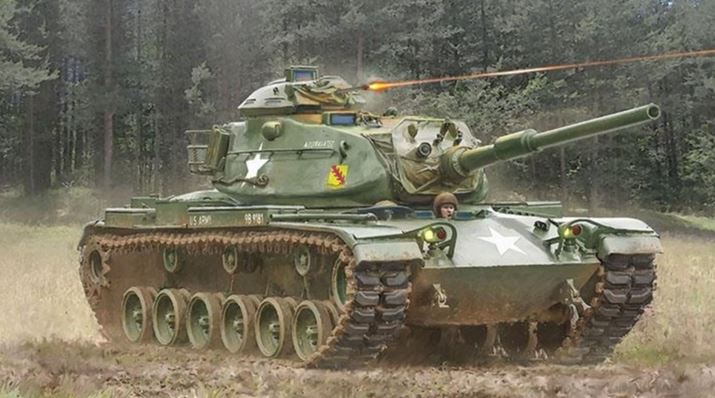
USA 2th generation main battle tank with a 105 mm Gun
The M60 A1 Tank is a second generation American made main battle tank. The M60 was first produced in 1959. It is an evolution of the earlier M48 tank and was intended to help the US maintain parity with Soviet tanks such as the T-62 and T-72. The M60 was America's primary main battle tank during the Cold War era. The M60 tank was first employed in combat by Israel during the Yom Kippur War in 1973. The M60 was also used by Israel in the Lebanon War in 1982, by Iran in the Iran Iraq War, and in the Gulf War. The M60 was officially retired from front line service in 1997 but remains in use with many countries around the world. The M60 was replaced by the M1 Abrams. The M60 is armed with a 105 mm main gun. The tank weighs 47 tons and has a crew of four. It is also armed with a 7.62 x 51 mm machine gun and is powered by a twin turbo diesel engine. The M60 is the last US main battle tank to use homogeneous steel armor.
M106 APC - Cold War-era (1947-1991) 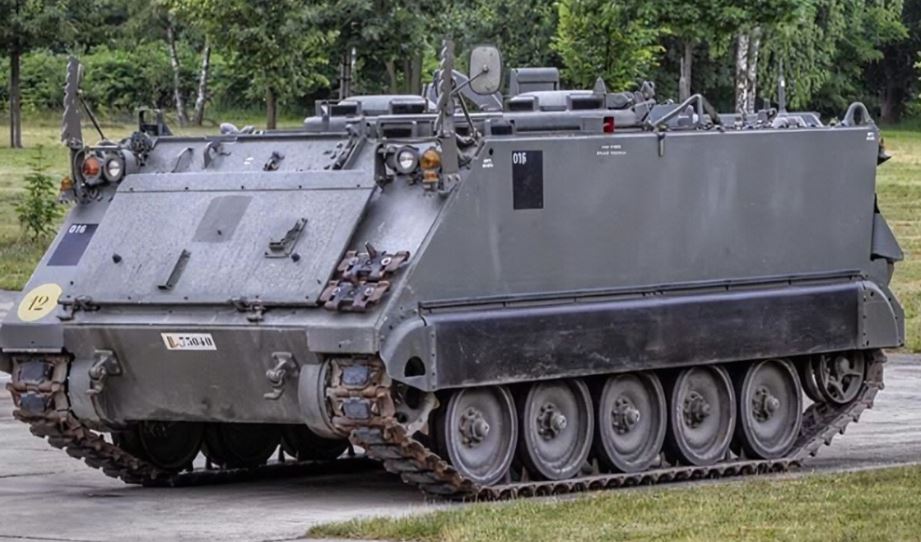
USA Armored Personnel Carrier (APC)
The M106 is a variant of the M113 APC designed to carry a 107 mm M30 mortar. It was intended to provide artillery support for mechanized infantry battalions. The M106 was introduced in 1964 and deployed to Vietnam. The M106 had a crew of six, was powered by a 210 hp diesel engine and had a range of 250 miles. In addition to its 4.2 inch M30 mortar, the M106 was armed with a M2 Browning machinegun. the M106 typically carried 88 rounds of ammunition for the mortar.
M151Jeep
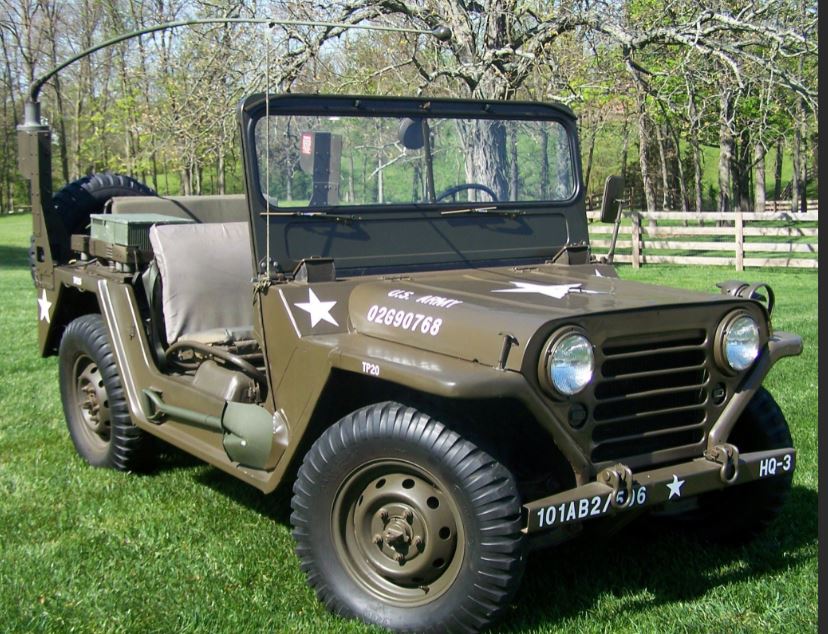
USA Utility Jeep, 1/4 Ton, 4x4 w/Tow
The M151 Utility Truck was the successor to the M38 Light Utility Vehicle. It was first produced in 1958. The M151 remained in production until 1988. During this time, 100,000 were produced. The M151 is still in service today and has had the longest service life of its genre of vehicles. It has been superseded by the HMMWV. The M151 was initially developed and produced by Ford, but later also produced by Kaiser and AMC. The M151 is a departure from the earlier M38 design using a unibody structure instead of a body and frame construction. This gives the M151 a lower center of gravity and a higher ground clearance. The M151 is also equipped with an independent suspension and coil springs. This enhances its cross-country performance and offers a more comfortable ride. Unlike the HMMWV, the M151 can be loaded into a heavy transport helicopter and for this reason, it was used by the USMC in Kosovo. The M151 is currently in service in over 100 countries worldwide.
M109A1 American 155 mm, turreted self-propelled Howitzer

The M109A1 is an American made 155 mm turreted self propelled howitzer. The M109 was introduced into service in 1963 and is the most common indirect fire support weapon for maneuver brigades of armored and mechanized infantry divisions. The M109 has a crew of four including a commander, driver, loader and gunner. The M109 was first used by US forces in Vietnam and was later used by Israeli forces in the Yom Kippur War. The M109 was also used in the 1991 Gulf War and the Iraq War in 2003. The M109 has a maximum range of 216 miles and a top road speed of 35 mph. The maximum range of its conventional munitions is 13 miles.
M107 American 175 mm self-propelled gun
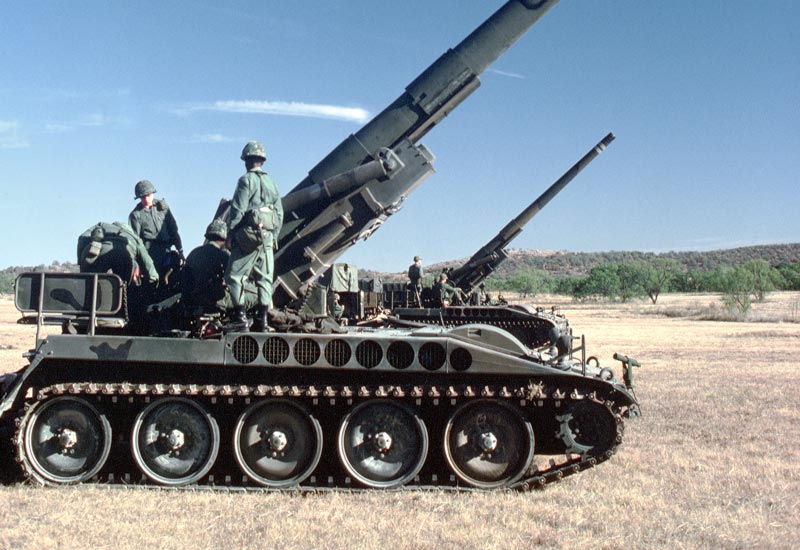
The M107 is a self propelled 175 mm howitzer designed in the early 1960s to provide long-range artillery in an air-transportable system. The M107 saw service in the 1960s and 1970s and was used by American forces during the Vietnam war. The M107 is powered by a 450 hp turbo supercharged diesel engine. The engine also powers a hydraulic pump which is used to traverse the turret. The vehicle has a rear spade which is positioned into the ground once the vehicle is ready for firing which stabilizes the vehicle. The M107 has a crew of 13. The M107 had one of the longest ranges of any mobile artillery piece during the Vietnam War. Its capability of long range fire and its mobility made it a very effective weapons system.




